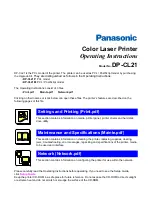
Transmission Using IPsec
For securer communications, this machine supports the IPsec protocol. When applied, IPsec encrypts
data packets at the network layer using shared key encryption. The machine uses encryption key
exchange to create a shared key for both sender and receiver. To achieve even higher security, you can
also renew the shared key on a validity period basis.
• IPsec is not applied to data obtained through DHCP, DNS, or WINS.
• IPsec compatible operating systems are Windows XP SP2, Windows Vista/7, Windows Server
2003/2003 R2/2008/2008 R2, Red Hat Enterprise Linux WS 4.0, and Solaris 10. However,
some setting items are not supported depending on the operating system. Make sure the IPsec
settings you specify are consistent with the operating system's IPsec settings.
• If you cannot access Web Image Monitor due to IPsec configuration problems, disable IPsec on
the [Network 2] tab under [Printer Configuration] using Smart Organizing Monitor, and then
access Web Image Monitor.
• For details about specifying the IPsec settings using Web Image Monitor, see page 47 "Using Web
• For details about enabling and disabling IPsec using Smart Organizing Monitor, see the Smart
Organizing Monitor Help.
Encryption and Authentication by IPsec
IPsec consists of two main functions: the encryption function, which ensures the confidentiality of data,
and the authentication function, which verifies the sender of the data and the data's integrity. This
machine's IPsec function supports two security protocols: the ESP protocol, which enables both of the
IPsec functions at the same time, and the AH protocol, which enables only the authentication function.
ESP Protocol
The ESP protocol provides secure transmission through both encryption and authentication. This
protocol does not provide header authentication.
• For successful encryption, both the sender and receiver must specify the same encryption
algorithm and encryption key. The encryption algorithm and encryption key are specified
automatically.
• For successful authentication, the sender and receiver must specify the same authentication
algorithm and authentication key. The authentication algorithm and authentication key are
specified automatically.
AH Protocol
The AH protocol provides secure transmission through authentication of packets only, including
headers.
7. Appendix
94
Содержание SP 310 DN
Страница 2: ......
Страница 6: ...Trademarks 110 INDEX 113 4...
Страница 14: ...12...
Страница 26: ...1 Guide to the Machine 24...
Страница 40: ...11 Click Close 2 Loading Paper 38...
Страница 48: ...3 Printing Documents 46...
Страница 74: ...5 Maintaining the Machine 72...
Страница 94: ...6 Troubleshooting 92...
Страница 107: ...USB 2 0 Wi Fi Printer language PCL6c Fonts 80 fonts Specifications of the Machine 105...
Страница 114: ...7 Appendix 112...
Страница 116: ...U Upgrade 21 W Web Image Monitor 47 Where to put the printer 16 Wireless LAN settings 51 61 114...
Страница 117: ...MEMO 115...
Страница 118: ...MEMO 116 GB GB EN US EN AU M174 8600...
Страница 119: ...2013...
Страница 120: ...M174 8600 AU EN US EN GB EN...
















































